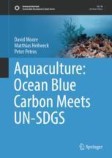Search
Search Results
-
Organic carbon utilisation by the filamentous alga Tribonema
Filamentous algae have potential application to wastewater treatment, in particular for efficient recovery of nutrients into biomass. However,...

-
Utilisation and transformation of organic and inorganic nitrogen by soil microorganisms and its regulation by excessive carbon and nitrogen availability
The process of nitrogen (N) transformation after microbial utilisation of organic and inorganic N is unclear. 15 N -glycine (Gly), 15 NH 4 + and 15 NO 3 − ...

-
Carbon Dioxide vs. Bicarbonate Utilisation
While CO2 is the external inorganic carbon (Ci) form used for photosynthesis in terrestrial plants, the higher concentration of bicarbonate (HCO3−)...
-
Genome assembly of Ottelia alismoides, a multiple-carbon utilisation aquatic plant
ObjectivesOttelia Pers. is in the Hydrocharitaceae family. Species in the genus are aquatic, and China is their centre of origin in Asia. Ottelia...
-
Syzygium cumini anthocyanins: recent advances in biological activities, extraction, stability, characterisation and utilisation in food systems
Syzygium cumini anthocyanins have become an area of great interest as biocolourants in the food industry. These anthocyanins impart a deep colour...

-
Assessment of biomass and carbon storage of a Populus simonii windbreak located in the Western Cape Province, South Africa
The integration of trees within agricultural systems delivers the opportunity to provide multiple benefits over those afforded by agriculture without...

-
Microbiota in Sustainable Degradation of Organic Waste and Its Utilisation in Agricultural Industry
Biological treatment is a method that employ to degrade organic waste. Because of their metabolic activity, microorganisms can survive in every...
-
The Fate of Soil Organic Carbon from Compost: A Pot Test Study Using Labile Carbon and 13c Natural Abundance
Recycled organic waste (OW) can be a valuable nutrient source for plant cultivation; however, knowledge is poor regarding its effect on soil carbon...

-
Hydrogen and formate production and utilisation in the rumen and the human colon
Molecular hydrogen (H 2 ) and formate (HCOO − ) are metabolic end products of many primary fermenters in the mammalian gut. Both play a vital role in...
-
Comparing Industrial and Biotechnological Solutions for Carbon Capture and Storage
We deal with the current artificial/industrial Carbon Dioxide Capture, Utilisation .and Storage (CCUS) solutions and show their power and potential...
-
Long-Term Grazing Exclusion Increases Ecosystem Carbon Stock but Decreases Nitrogen Stock in the Karst Alpine Grassland of China
Grazing management practices are a major factor regulating nutrient cycling and plant growth in grasslands. However, the response of long-term...

-
Develo** and evaluating strategies to increase the material utilisation rate of hardwoods: a hybrid policy Delphi-SWOT analysis
The indigenous hardwoods in German forests have a substantial ability to store carbon, and forestry reconstruction measures are anticipated to result...

-
Carbon Sequestration and Storage in European Forests
European forests have been acting as a significant carbon sink for the last few decades. However, there are significant distinctions among the forest...
-
Food Processing By-Products and Waste Utilisation for Bioethanol Production
Globally, a rising trend in population and economy has caused an increase in the global demand for energy. Although, fossil fuels have been the most...
-
Energy Use and Carbon Emissions of Walnut Production in Türkiye
The objective of this study is to investigate the energy efficiency and greenhouse gas emissions associated with walnut production. The research will...

-
Dermatobacter hominis gen. nov., sp. nov., a new member of the family Iamiaceae, revealed the potential utilisation of skin-derived metabolites
A non-motile, novel actinobacterial strain, Kera-3 T , which is a gram-positive, aerobic, rod-shaped bacterium, was isolated from human keratinocytes...

-
Carbon Footprint of Different Energy-Intensive Systems
Global warming, which is produced by an increase in greenhouse gas concentrations in the atmosphere, has become the most important environmental...
-
Impact of Land Uses on Soil Organic Carbon Dynamics in the Indian Himalayan Region
Land use contributes to enhance food, fodder and firewood in the society, promoting sustainability and livelihood security. The land use systems also...
-
Tributary Inflows to a Regulated River Influence Bacterial Communities and Increase Bacterial Carbon Assimilation
Inflows from unregulated tributaries change the physical, chemical, and biotic conditions in receiving regulated rivers, impacting microbial...

-
Labile carbon inputs support the recovery of bacterial communities, but not fungal communities, from a simulated bovine urine event
Inputs of carbon to soil may be used to stimulate microbial growth and immobilize excess nitrogen from sources such as livestock urine. However, the...

